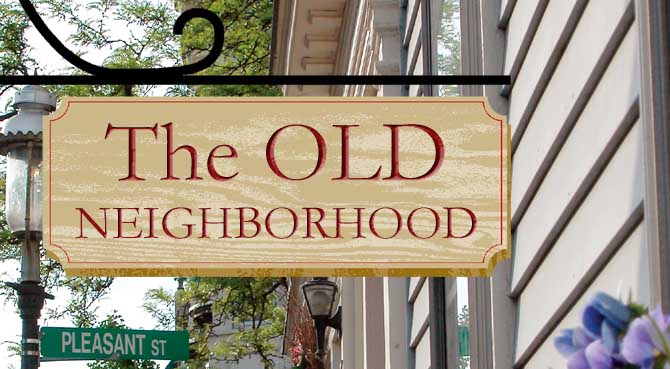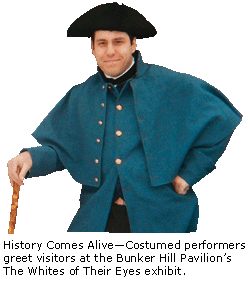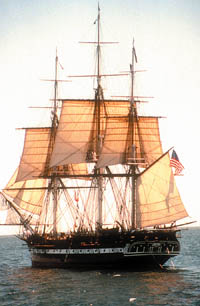
Discover the Colonial charm
of historic Charlestown
by Christine Celli
Back in the day—okay way back in the day—Charlestown was the place to be in these parts. Thanks to its waterfront locale, early settlers felt the area had an edge over what is now Boston. So in 1628, when it came time to choose a first home in the New World, Colonists chose Charlestown.
 Unfortunately
in the years that followed, those bragging rights have at times
been forgotten. In 1874, Charlestown was annexed by Boston,
allegedly because Protestants in the area were uncomfortable with
the rapid influx of Irish Catholics. This change did nothing to
enhance Charlestown’s reputation, further spurred, perhaps, by
the sooty, elevated train that blocked the sun in the early 1900s
and the post-Vietnam demise of a grand Navy Yard that in its
heyday built more than 200 warships.
Unfortunately
in the years that followed, those bragging rights have at times
been forgotten. In 1874, Charlestown was annexed by Boston,
allegedly because Protestants in the area were uncomfortable with
the rapid influx of Irish Catholics. This change did nothing to
enhance Charlestown’s reputation, further spurred, perhaps, by
the sooty, elevated train that blocked the sun in the early 1900s
and the post-Vietnam demise of a grand Navy Yard that in its
heyday built more than 200 warships.
These days, however, it’s all history—in that quaint, classic New
England sense of the word. The Bunker Hill Monument proudly
commemorates the area’s ties to the Revolutionary War, the El
train was long ago replaced by the underground Orange Line, the
Charlestown Navy Yard has been converted to a public park that
once again attracts countless visitors, and, just like in the
early days, everyone seems to want to move to the neighborhood
(the soaring home prices will attest to that!). If you haven’t
yet crossed over the Charles River Dam to see what all the fuss
is about, start following the Freedom Trail (it heads right
there), then follow our advice.
MONUMENTS AND MOORINGS
Situated slightly north of Boston proper, Charlestown is very
much a part of the city and is just a short walk from the North
End or from the Community College stop on the Orange Line. The
first thing you see when you get there—the towering monument to
the Battle of Bunker Hill—is also the best place to start your
visit.
The Bunker Hill Monument (Breed’s Hill, 617-242-5641) is a 221-foot granite obelisk that was completed in 1842 to memorialize the lives lost during this key Revolutionary War battle. You can survey the surrounding land by climbing the 294 steps to the top (it’s free!), then learn why the monument was built in the first place by taking in the historical exhibits at The Whites of Their Eyes presentation at Bunker Hill Pavilion. There, you’ll learn that although the Patriots actually lost the Battle of Bunker Hill to the British, it served as a great moral victory because the Revolutionaries were ill-equipped to fight against the well-armed Redcoats (who lost more soldiers in the battle). The multi-media presentation chronicles the famous order from Patriot Colonel Prescott, who exclaimed, “Don’t fire until you see the whites of their eyes,” as the colonists sought to conserve scarce ammunition. You’ll also learn how the battle was actually fought on Breed’s Hill (not nearby Bunker Hill). The 20-minute show features projected images and special effects. The exhibit it located down the hill from the monument and all Old Town Trolley ticket holders receive free admission (refer to listing here).
 OLD GLORY June might be the best time of the year to visit Charlestown thanks to two holidays the area loves to celebrate—Flag Day and Bunker Hill Day (which also happens to be a city holiday). The events kick off on Flag Day, June 12, and run through June 17, the day the British defeated local militia in what is commonly referred to as the Battle of Bunker Hill. The following is a list of Bunker Hill Weekend highlights:
For more information on any of these events call 617-242-5601. |
The Charlestown Navy Yard, home to both the U.S.S. Constitution (a.k.a. “Old Ironsides”) and the U.S.S. Cassin Young, is also a great place to learn about the community’s storied naval history. The two ships are perfect examples of the Yard’s longtime tradition of shipbuilding. The Cassin Young is a World War II destroyer that was built in 1943, while “Old Ironsides,” launched in 1797, is the oldest commissioned warship afloat in the world. They are docked side-by-side in the Navy Yard and are open for tours (refer to listing here).
The U.S.S. Constitution boasts a whole museum dedicated to its
history that is also worth a visit. There you’ll learn how “Old
Ironsides” got her name and what it was like to serve on the
ship, through interactive exhibits and stories of former sailors
who fought aboard it during the War of 1812. The museum is
located across from the ship itself in the Navy Yard (refer to
listing here).
EVER-CHANGING CHARLESTOWN
Charlestown has been subjected to countless facelifts
over the years. First the Revolutionary War left the region
severely damaged by fire. The once-thriving Colonial town was
eventually rebuilt and enjoyed a prosperous time as the center of
transportation and maritime industry in the 19th
century. Unfortunately, in the second half of the 20th century,
the sagging shipbuilding industry was in turmoil. By the 1970s,
the Navy ended it altogether, officially closing Charlestown Navy
Yard.
A push to desegregate schools in Boston led to heated and often violent race riots—especially in heavily Irish communities like Charlestown and South Boston. But in the 1980s, Charlestown’s close proximity to the fast-developing Financial District served to boost its real estate market and once again revitalized the community’s economy.
If you walk along Warren Avenue today and down some of its side streets you’ll see the newly renovated homes of Charlestown’s original settlers—now occupied by the current community of upperclass 30-somethings who have made the area their own. The earliest homes are wood and built in the Federalist style made popular by famed architect Charles Bulfinch. But you can also spot houses built slightly later like the brick, Greek Revival row houses from the early 19th century and the more ornate but also rare Queen Anne-style homes that look almost like medieval castles.
For the most stunning example of new development, visit City
Square Park (on the corner of Rutherford Avenue and City Square).
The park was fashioned on 40 acres of new green space created
thanks to the Big Dig and debuted in the late ’90s. The centrally
located park is a good place for a break and for views of the
crown jewel of the Big Dig, the Leonard P. Zakim Bunker Hill
Bridge.
 NOSHING AND NIGHTLIFE
NOSHING AND NIGHTLIFE
If there was one pub in town where everyone knew Paul
Revere’s name, it was the Warren Tavern (2 Pleasant St.,
617-241-8142). Revere was a regular there in its early days, when
even George Washington was once a patron. These days the tavern,
named after a fallen hero of Bunker Hill, Joseph Warren, is more
likely packed with locals in New England Patriots t-shirts than
actual Revolutionaries. But they serve up a terrific hamburger
and other refreshments, and the space looks much as it did when
it first opened in 1780.
In Boston, celebrities generally only come in three flavors:
politicians, sports heroes and chefs. Julia Child represents the
most glittering example of the latter, but Charlestown holds
claim to another biggie, Todd English. These days English can be
seen everywhere from PBS to “The Iron Chef,” and his national
notoriety all began with the opening of Olives (10 City Square,
617-242-1999) in 1989. The restaurant boasts ample plates of
creatively concocted Mediterranean cuisine. And from all
accounts, the food is well worth the long waits and steep prices
(they don’t take reservations). If you’d prefer a less expensive
(but no less popular) way to check out English’s cooking, try
Figs (67 Main St., 617-242-2229) for inspired, brick oven pizzas
the whole family will love.

back to homepage
 SHIP
SHAPE SHIP
SHAPEFrom the Boston Tea Party to “Old Ironsides” and the shipbuilding tradition of the Charlestown Navy Yard to its status as one of the country’s busiest ports, Boston’s waterfront has played host to decades of activity. Unfortunately, all those years of action left a whole lot of pollution that kept even locals far from the sea. After a long and ongoing cleanup of Boston Harbor, the city sought a way to welcome visitors back to its shores. Enter the Boston Seaport Festival, a weekend-long event that honors Boston’s maritime past and present. Held June 12 & 13, the family-friendly festival is jam-packed with seafaring activities at the Charlestown Navy Yard and other locations along Boston Harbor. Highlights include the U.S.S. Constitution Turnaround Cruise (pictured right) on June 12 from 10 a.m.–noon, the Schooner Race presented by the Liberty Fleet of Tall Ships June 13 at 1 p.m. and the Festival Parade of Lights, which illuminates the night June 12 at 8 p.m. and features more than 30 lighted sailing vessels on parade from Castle Island through the inner harbor to the Charlestown Navy Yard. That should prove that while, these days, locals may prefer our harbor steeped in history instead of tea, we still know how to throw a party. —Cary Purcell |